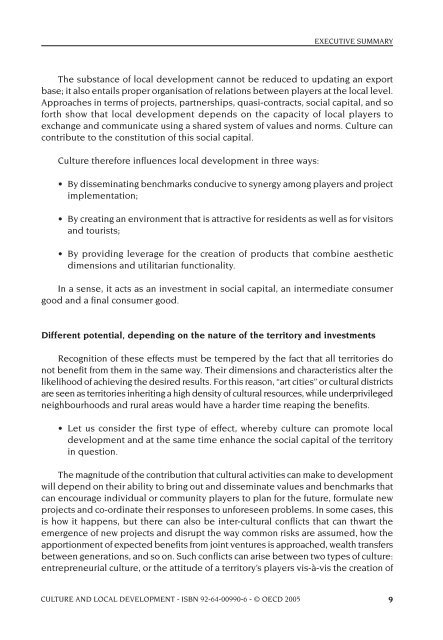OECD Culture and Local Development.pdf - PACA
OECD Culture and Local Development.pdf - PACA
OECD Culture and Local Development.pdf - PACA
Create successful ePaper yourself
Turn your PDF publications into a flip-book with our unique Google optimized e-Paper software.
EXECUTIVE SUMMARY<br />
The substance of local development cannot be reduced to updating an export<br />
base; it also entails proper organisation of relations between players at the local level.<br />
Approaches in terms of projects, partnerships, quasi-contracts, social capital, <strong>and</strong> so<br />
forth show that local development depends on the capacity of local players to<br />
exchange <strong>and</strong> communicate using a shared system of values <strong>and</strong> norms. <strong>Culture</strong> can<br />
contribute to the constitution of this social capital.<br />
<strong>Culture</strong> therefore influences local development in three ways:<br />
• By disseminating benchmarks conducive to synergy among players <strong>and</strong> project<br />
implementation;<br />
• By creating an environment that is attractive for residents as well as for visitors<br />
<strong>and</strong> tourists;<br />
• By providing leverage for the creation of products that combine aesthetic<br />
dimensions <strong>and</strong> utilitarian functionality.<br />
In a sense, it acts as an investment in social capital, an intermediate consumer<br />
good <strong>and</strong> a final consumer good.<br />
Different potential, depending on the nature of the territory <strong>and</strong> investments<br />
Recognition of these effects must be tempered by the fact that all territories do<br />
not benefit from them in the same way. Their dimensions <strong>and</strong> characteristics alter the<br />
likelihood of achieving the desired results. For this reason, “art cities” or cultural districts<br />
are seen as territories inheriting a high density of cultural resources, while underprivileged<br />
neighbourhoods <strong>and</strong> rural areas would have a harder time reaping the benefits.<br />
• Let us consider the first type of effect, whereby culture can promote local<br />
development <strong>and</strong> at the same time enhance the social capital of the territory<br />
in question.<br />
The magnitude of the contribution that cultural activities can make to development<br />
will depend on their ability to bring out <strong>and</strong> disseminate values <strong>and</strong> benchmarks that<br />
can encourage individual or community players to plan for the future, formulate new<br />
projects <strong>and</strong> co-ordinate their responses to unforeseen problems. In some cases, this<br />
is how it happens, but there can also be inter-cultural conflicts that can thwart the<br />
emergence of new projects <strong>and</strong> disrupt the way common risks are assumed, how the<br />
apportionment of expected benefits from joint ventures is approached, wealth transfers<br />
between generations, <strong>and</strong> so on. Such conflicts can arise between two types of culture:<br />
entrepreneurial culture, or the attitude of a territory’s players vis-à-vis the creation of<br />
CULTURE AND LOCAL DEVELOPMENT - ISBN 92-64-00990-6 - © <strong>OECD</strong> 2005 9














